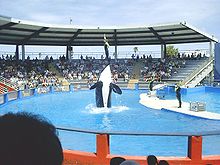Lolita (orca): Difference between revisions
Not a reliable source or neutral in it matter. |
Added source |
||
| Line 1: | Line 1: | ||
[[Image:Miami Oceanarium.jpg|right|thumb|Lolita performing at Miami Seaquarium]] |
[[Image:Miami Oceanarium.jpg|right|thumb|Lolita performing at Miami Seaquarium]] |
||
'''Lolita''' is an [[orca]] |
'''Lolita''' is an [[orca]] who has been part of the [[Miami Seaquarium]] family for almost 40 years.<ref>http://www.miamiseaquarium.net/</ref> |
||
==Early Life== |
==Early Life== |
||
On August 8, 1970 in Puget Sound Lolita along with seven others were caught to be sold to marine parks and aquariums. Tokitae, as she was originally named, was purchased by Seaquarium veterinarian Dr. Jesse White for about $20,000. <ref name=”Seattle Times”>[http://seattletimes.nwsource.com/html/travel/2012903643_webwhale16.html]</ref> Upon arrival to the Seaquarium Lolita joined another Southern Resident Orca named Hugo who was captured some time before Lolita and had lived in the park two years prior to her arrival. At first they were housed apart so they wouldn’t fight but they were eventually put together. Tokitae was re-named Lolita “after the heroine in Vladimir Nabokov’s novel by The News.” <ref>http://news.google.com/newspapers?id=3KoyAAAAIBAJ&sjid=pegFAAAAIBAJ&dq=lolita%20killer%20whale%20hugo&pg=7210%2C4276198</ref> |
On August 8, 1970 in Puget Sound Lolita along with seven others were caught to be sold to marine parks and aquariums. Tokitae, as she was originally named, was purchased by Seaquarium veterinarian Dr. Jesse White for about $20,000. <ref name=”Seattle Times”>[http://seattletimes.nwsource.com/html/travel/2012903643_webwhale16.html]</ref> Upon arrival to the Seaquarium Lolita joined another Southern Resident Orca named Hugo who was captured some time before Lolita and had lived in the park two years prior to her arrival. At first they were housed apart so they wouldn’t fight but they were eventually put together. Tokitae was re-named Lolita “after the heroine in Vladimir Nabokov’s novel by The News.” <ref>http://news.google.com/newspapers?id=3KoyAAAAIBAJ&sjid=pegFAAAAIBAJ&dq=lolita%20killer%20whale%20hugo&pg=7210%2C4276198</ref> |
||
Revision as of 17:41, 4 March 2011

Lolita is an orca who has been part of the Miami Seaquarium family for almost 40 years.[1]
Early Life
On August 8, 1970 in Puget Sound Lolita along with seven others were caught to be sold to marine parks and aquariums. Tokitae, as she was originally named, was purchased by Seaquarium veterinarian Dr. Jesse White for about $20,000. [2] Upon arrival to the Seaquarium Lolita joined another Southern Resident Orca named Hugo who was captured some time before Lolita and had lived in the park two years prior to her arrival. At first they were housed apart so they wouldn’t fight but they were eventually put together. Tokitae was re-named Lolita “after the heroine in Vladimir Nabokov’s novel by The News.” [3]

Hugo and Lolita got along well with each other during the years they spent together but on the morning of March 4, 1980 staff arrived to find a lifeless Hugo. “We found her bumping up against Hugo’s body. It’s impossible to know what she was thinking. They were very protective of one another when one of them was sick. I’d just like to forget about that day.” recalls trainer Eimstad.[4] Hugo had suffered a brain aneurism.[5] “We expected problems when Hugo died but Lolita preformed as usual the next day,” trainer Lou Roth recalls “Once in a while she would look for him, but she got over it.”[6] Even though the pair had bred many times (once to the point of having to suspend shows[7]) the two never produced any live offspring.[8]
References
- ^ http://www.miamiseaquarium.net/
- ^ [1]
- ^ http://news.google.com/newspapers?id=3KoyAAAAIBAJ&sjid=pegFAAAAIBAJ&dq=lolita%20killer%20whale%20hugo&pg=7210%2C4276198
- ^ http://news.google.com/newspapers?id=ILdUAAAAIBAJ&sjid=zzsNAAAAIBAJ&dq=lolita%20killer%20whale%20hugo&pg=1121%2C1758631
- ^ http://news.google.com/newspapers?id=33lIAAAAIBAJ&sjid=AIMMAAAAIBAJ&dq=hugo%20killer%20whale%20aneurysm&pg=1156%2C346339
- ^ http://news.google.com/newspapers?id=1cUxAAAAIBAJ&sjid=eI0DAAAAIBAJ&dq=lolita%20roth%20happy%20gentle&pg=2682%2C158088
- ^ http://news.google.com/newspapers?id=G_QiAAAAIBAJ&sjid=_8wFAAAAIBAJ&dq=lolita%20killer%20whale%20hugo&pg=2616%2C2364689
- ^ http://news.google.com/newspapers?id=1cUxAAAAIBAJ&sjid=eI0DAAAAIBAJ&dq=lolita%20killer%20whale%20hugo%20died&pg=2682%2C158088
